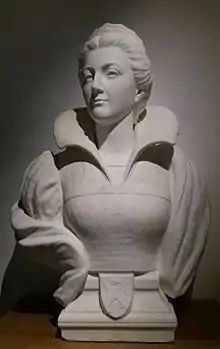Clémence de Bourges
Clémence de Bourges (c.1530 – c.1563) was a French poet and noblewoman, and a literary figure of the Renaissance.

Clémence was the daughter of Claude de Bourges, seigneur of Mions in the Dauphiné; Claude was the lieutenant-general of finance for Piedmont and an official of the city of Lyon. Clémence belonged to the literary circle that gathered around Maurice Scève, Lyon's leading poet.[1] Her own work has not survived, though it was still known in the mid-18th century,[2] and she is now remembered mainly through the praises recorded by her contemporaries.[3]
Clémence had been due to marry Jean du Peyrat, a Lyonnaise nobleman who died during the siege of Beaurepaire by Protestant forces in 1561/2; it is claimed that she afterwards died of grief and shock.[4]
Another female poet of the era, Louise Labé, dedicated her collected works to Clémence in 1555, subsequently lamenting her early death,[5] and Claude de Rubys, who also knew her, referred to her as "ceste perle vrayement orientale entre les damoiselles de Lyon".[6] Louise's "epistre" to Clémence makes it clear that they were firm friends of long standing, despite apparent differences in age and social status.[7]
References
- "Maurice Scève". Oxford Bibliographies. Retrieved 19 February 2019.
- Histoire litteraire des femmes francoises, ou lettres historiques et critiques (etc.). Lacombe. 1769. p. 102.
- Rainer Maria Rilke (2016). The Notebooks of Malte Laurids Brigge. Oxford University Press. p. 188. ISBN 978-0-19-964603-6.
- "Petit historique du château de Beaurepaire" (PDF). Beaurepaire en Bresse. Retrieved 19 February 2019.
- Judith Thurman (August 1975). I became alone: five women poets, Sappho, Louise Labé, Ann Bradstreet, Juana Ines de la Cruz, Emily Dickinson. Atheneum. p. 39. ISBN 978-0-689-30487-3.
- Mireille Huchon; Louise Labé (2006). Louise Labé : Une créature de papier. Librairie Droz. p. 62. ISBN 978-2-600-00534-0.
- Deborah Lesko Baker; Tom Conley (1996). The Subject of Desire: Petrarchan Poetics and the Female Voice in Louise Labé. Purdue University Press. p. 11. ISBN 978-1-55753-088-2.